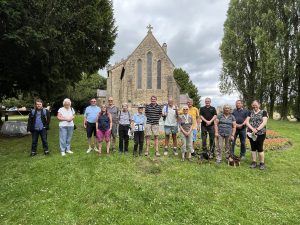It may not have involved as many people as the tradition it seeks to remember, but we enjoyed retracing the footsteps of local villagers when we took part in the annual Brinsley coffin walk last weekend.
The event, which celebrates its 20th anniversary this year, is the modern-day tribute to residents who lived in Brinsley around 150 years ago, before the village had its own church.
It meant that there was nowhere local for the villagers to bury their dead, forcing them to carry the coffins containing their loved ones the three miles across the field to nearby Greasley.
There, they were able to bury them by delivering them to their final resting place, the churchyard of St Mary’s Church.
The practice came to an end in 1861, when St James The Great Church in Brinsley finally opened, but the tradition was revived in 2004 by a local historian, the late Stan Smith.
He wanted to pay tribute to the villagers’ fortitude and so started the coffin walk which, for many years, involved a full-sized coffin and a number of mourners, who, as tradition dictates, stop for a moment of reflection at the Brinsley Colliery Headstocks and, at the halfway point, stopping at a stone where, in days gone by, the villagers would rest the coffin and enjoy some liquid refreshment.
At journey’s end, at St Mary’s, there is also a short ceremony of commemoration to the villagers.
Joanne Hutsby, a partner at Gillotts Funeral Directors who took part in this year’s walk, said: “We used a miniature coffin this year but observed all of the usual traditions, albeit we stopped at where the headstocks used to be before they’d been recently removed.
“It’s always remarkable to think about how hard it must have been for everyone to undertake such a journey through all weathers throughout the year. They must have been so relieved when they got their own church, bringing the coffin walks to an end.”



